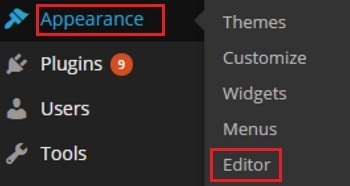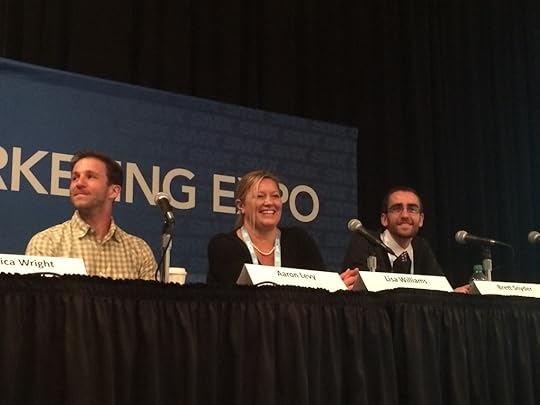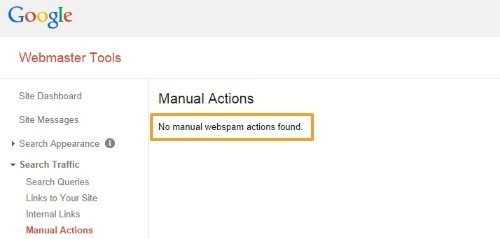Bruce Clay's Blog, page 41
September 30, 2014
SMX East Liveblog: All Search is Now Social
SMX East Liveblog: All Search is Now Social was originally published on BruceClay.com, home of expert search engine optimization tips.
Think of an apple and a bag of marbles. Both simple images, and when you compare the two you’ll get an idea of the shift that social media has caused brands to make to stay relevant today. An apple is the old way of thinking of your brand, unified and on-message. The bag of marbles is a little more assorted, a collection, not a unified message but it has 300% more surface area. If you’re able to increase the surface area of your brand by releasing individual advocates. Social media advocacy gives your business authentic reach. Speaker Tami Cannizzaro explains.

Tami Cannazzaro, IBM Global Director of Marketing, says the apple is out.
Speaker: Tami Cannizzaro, Global Director of Marketing, Social Business, IBM (@tamicann)
She leads the “Smarter Commerce Initiative” at IBM. She says we’re in a period of so much change in marketing. Have you heard of Ello? In a period of 12 hours everyone on Facebook was talking about Ello. Social today is, more often than not, the authentic face of your brand. She’ll tell us how IBM has taken advantage of social.
A couple tools for allowing social media advocacy to give your business authentic reach.
1. Voices among employees. IBMers are encouraged to share voice and perspective within communities.
2. Inflencer marketing. She asked if it could scale and move the needle. Guest blogging, speaking, aligning, project together like an ebook or webcast — these are the opportunities IBM could give to influencers. She says it was about building real relationships.
If social is discovery, search is validation. Content marketing is the engine that drives search rank and brand engagement. How to build the content marketing engine:
1. Tap into cultural ethos. What’s happening in pop culture? What’s happening around my Brand? What new Trends can I tap?
2. Build relevant, consistent content. At IBM they have a spectrum that content falls into.

Approach content marketing like a journalist, publishing across the spectrum of content types.
A weekly newsroom approach is how they do it. Goal To produce relevant content and real-time creative assets that support paid, owned, earned strategies, drive social selling and align with longer-term brand initiatives.
A cycle starts with a conversation to discuss news, events and trends. What’s happening in social that’s new and should be leveraged?
Then there’s the Editorial Sync, review and revise strategy and concept development. Then review the assets and adjust timelines. … She says that journalists are more suited for how content publication for brands works today vs. traditional marketers.
3. Optimize Paid, Earned and Owned. At the end of a week they may look at asset’s performance and put paid campaigns behind that content.
The third pillar of marketing today is finding relevant, shareable experiences. Here are examples.
American Express has become a trusted expert through their Open Forum, the number one social blog for mid-market businesses.
Nike builds community, with celebrities being advocates and then mobilizing community around shared interests like races or events at stores.
“Mean Stinks” anti-bullying campaign by deodorant brand Secret is an example of evoking emotion where customers can connect.
IBM partnered with TED and through this was able to provide moments of connection with customers in the resulting videos shared.
To review: 1. Think through how social is often discovery; 2. Having a robust content engine and mirror the market; 3. Build longer campaigns that builds community.
SMX East Liveblog: How SEO & SEM Can Help Each Other
SMX East Liveblog: How SEO & SEM Can Help Each Other was originally published on BruceClay.com, home of expert search engine optimization tips.
When SEO and SEM work together, the outcome is stronger campaigns for both sides. SEO and PPC VIPs Lisa Williams, Aaron Levy and Brett Snyder break down the relationship between SEO and SEM from an operational and tactical level during the first session of Search Marketing Expo (SMX) East 2014’s Tactics Track.
Lisa Williams: 10 Lessons From Disney Characters
Lisa Williams, president and founder of Sustainable Digital Marketing, will approach the relationship between SEO and SEM from an operational level, exploring how the two spheres can play nicely together. In thinking about this, she realized the place where we can best learn to play together well is from Disney movies, and accordingly her slides feature Disney movies embodying each lesson.
1. Strategy: “Big Thinking Proceeds Great Achievement”
SEO and SEM teams need to understand the goals of each side. Practically, that means being able to answer:
Who are we talking to?
What’s the compelling thing we do?
How do we measure success?
2. Learn to Partner: You can have different objectives and work together
What are our rules of engagement and how can we check each other’s expectations
Who’s at the table?
What can we learn from each other?
Have we defined a metric for team success?
Are we speaking the same language?
3. Create Culture of Teamwork: Are people incentivized to work together?
What are our values?
How are we aligning actions with values?
How do we measure a culture of teamwork?
4. Tell a Great Story: Account Managers are like “Content Concierges”
Telling a great story means getting the right content to the right people at the right time. Each brand/business should know:
Who are our storytellers?
What assets are we creating that SEO & SEM can leverage?
Where will we keep our stories?
5. Know What It Takes to Win
Do we know what it takes to win
Are we allowing for lots of way sot win?
6. Leverage Leadership
Someone has to own the project outcome.
Who is ultimately responsible for the outcome of an initiative?
Has leadership provided clarity?
Has leadership provided ownership?
7. Talent Diversification
Respect different talents necessary to win.
Do SEO and SEM teams have subject matter expertise?
Does talent have earning opportunities?
8. Allow for Change: There’s More than Just the Way You’ve Always Done It
Is it perfect? There’s room for change!
9. Deal with Fragmentation: Media Fragmentation is Reflective of Agency or Operational Fragmentation
Are teams fragmented or working together?
How can we improve fragmentation operationally?
10. Words Matter: Use More Words and Fewer Numbers in Analysis
Don’t just provide numbers — provide takeaways.
Does the data dive direction with words?
Is the data present for the right level?
Williams concludes by telling us that no matter what we do, be brave — just like our Disney heroes and heroines.
Brett Snyder: Embracing an Agile Methodology
View Snyder’s slides: bit.ly/letsworktogethersmx
Brett Snyder, owner of Brett Snyder Consulting, is an SEO who started in PPC, and says that this has given him unique insights into both spheres of Internet marketing.
Snyder asserts that PPC and SEO and two sides of the same brain, and calls PPC the more logical, analytical and objective side and SEO is the more intuitive, thoughtful, subjective side. He says that keyword research is the common foundation and also the fundamental difference between SEO and PPC.
We can each learn from each others’ reports, and says looking at the Search Terms Report to find new search terms is a must-do. He also is a fan of the search query report — it helps the PPC team learn from organic engagement and identify new opportunities.
Competitive Keyword Research with SEMRush
Synder says SEMrush is “shockingly undervalued in the SEO community.” Snyder likes to use SEMRush to pinpoint keywords that competitors are already ranking for but also bid on in AdWords — if your competitor is paying for traffic they already rank for, this indicates they are are high-priority search terms.
On-Page Optimization
Snyder goes to urge the audience to understand how people get to your website before they convert. Identify content gaps on referring sites and develop content to fill those gaps. Promote new content within same content network.
Off-Page Optimization
If you build it, they will come … is a lie. SEOs and SEMs know this.
Amplify your campaigns using paid media. He recommends social advertising via:
Content and display networks
StumbleUpon Paid Discovery (Snyder calls this a highly underused platform that yields real results).
Reddit Advertising (proceed with caution – Reddit-ers are very particular about the ads they see.
When it comes to SEO and SEM, Snyder advises that, in short, Internet marketers embrace collaboration.
Aaron Levy: PPC + SEO
View Levy’s slides: Bit.ly/ppcseolove
PPC is a means to solving who are the people searching for your targeted keywords – it’s far more than demographics. It’s getting to specifics – who are they? Levy tells us to know:
What excites them?
What scares them?
What has them waking at sunrise?
What do they love?
What do they do on their vacations?
What will they read? Save? Share?
What will make them give you money?
Query Mining & Question Mining
Clump queries together to find more data – separate things out by gender.
Have content that answers your consumers questions – formulate content based on long-tail queries your customers are searching for.
Retargeting: Stock Them Until they Love You and find Content Opportunities
With retargeting reports, we can know where consumers are going when they’re not on your site.
Here Comes the Bride: An Example
Levy found that when retargeting bridal ads, brides went to weather sites. That’s a tremendous opportunity to write an adverse weather guide for weddings.
They also go to celebrity gossip sites – which means you should do a celebrity wedding inspiration guide.
Real estate sites – they’re buying houses. Maybe that means an article like “Living Together After the Wedding” would be great.
POF/OK Cupid – this means there are a lot of window shoppers or bridesmaids are shopping on the site – it’s actually a bigger audience than just brides.
September 25, 2014
Summing Up a Summer of Search Engine Shuffling for SMBs & DIY Marketers
Summing Up a Summer of Search Engine Shuffling for SMBs & DIY Marketers was originally published on BruceClay.com, home of expert search engine optimization tips.
Your business is where it is today because you know how to do a lot of things well. When you don’t know how to do something, you identify the best person for the job. Where does your website and online presence fall on the spectrum of things you know and do yourself, on one end, versus the things you hire experts for, on the other?

Subscribe to the SEO Newsletter for the month’s Internet marketing news and tactics relevant to your online business: http://www.bruceclay.com/newsletter/
Odds are good that maintenance and promotion of your website fall somewhere in the middle of your skill set, from expert to overseer. Even if you’re hands off, it would do you good to know what’s new and next in SEO. That way, you can make sure your web presence is capitalizing on opportunities. To that end, you’ll find the latest SEO info from the last few months, and the search engine optimization tips it necessitates, in this article that covers:
The Google Quality Rating Guidelines, a brilliant resource that illuminates Google’s quality assurance program for its search results. Written for human QA reviewers, the document explains how to judge quality, on-page elements and reputation of websites in a variety of categories. Here we shed light on new ways to understand how Google determines expertise, authority and trust.
Google’s abandonment of authorship markup. Author photos and bylines next to search results are gone. So is the 35% click-through rate increase those photos seemed to generate. Do you have authorship markup on your site? Will you remove it? Maintain it? Nofollow links? Find out what to do about authorship markup here.
A new minor ranking signal in HTTPS (secure encryption). When Google confirms anything to be a factor in their ranking algorithm, businesses seeking a competitive edge take note. But before you demand your webmaster secure your entire site, learn the costs and requirements of HTTPS.
An adjustment to the local ranking algorithm known as the Pigeon Update. Google says the new local algorithm has improved distance and location ranking parameters and that the new local algorithm now more closely resembles the standard web algorithm. So, what does that mean for getting your business ranked in Google’s local search results? Read on.
SEO Insight in Google Quality Rating Guidelines
A March 2014 version of the Google Quality Rating Guidelines (the instructions Google gives to human quality raters for QAing their search results) was leaked this summer. It’s a total rewrite of the previous version and about double the size. This new version is version 5, and it includes some new terms and concepts that have search marketers pretty excited.
First there’s the term “E-A-T,” which stands for expertise, authority and trust. Now you can refer to this fancy new acronym when framing the importance of issues like quality content, author authority, necessary site components like a Privacy Policy and customer support, and other signals of, well, E-A-T.
Another concept that stood out in the v5 Guidelines include emphasis on website maintenance. This means don’t let pages sit stale too long; even the home page and other key landing pages should be kept up to show that someone cares for and maintains the site.
The document describes differing standards for varying types of pages. For instance, Google provides guidance for evaluating the following types of websites differently, noting that the purpose of content, expectations of users and qualifications of expertise are different for each:
encyclopedia pages
news sites
humor sites
forums and Q&A sites
PFD (porn, foreign language and didn’t load results)
YMYL (“Your Money or Your Life”)
For the YMYL category, it’s important to understand Google sets the highest standards for content related to a person’s health, finances and well being. If your site falls into a YMYL category (including sites that accept payment), Google has a higher standard of excellence for you.
What We’re Doing with the Quality Rating Guidelines
The Quality Rating Guidelines Version 5.0 is a 160-page, printed and bound reference book in the office. While concepts like expertise, authority and trust, freshness and reputation were understood to be the qualities by which content and websites are evaluated, marketers can communicate those concepts with an enriched vocabulary. Expect to hear any informed search marketer talk about E-A-T, YMYL and Do-Know-Go (a shorthand phrase for the three types of user intent a web page might satisfy ━ take an action, learn information, navigate).
For more on what it means to establish E-A-T on your website, watch Bruce Clay, Inc.’s SEO Manager Mindy Weinstein and Sr. Lead SEO Analyst Rob Ramirez talking about takeaways from the guidelines in this video hangout recorded on August 18 (from 23:10 to the end).
Abandoned SERP Enhancement: Authorship Markup
Google says that it’s not using authorship markup data at all anymore. Authorship markup was a way of signaling to Google the Google+ profile associated with an article’s author, from which Google could add an author headshot and byline to an article listing on a search engine results page (SERP).
The devaluation of authorship markup was gradual. First they did away with author photos in SERPs in June or July. At that point the author’s byline and other stats, like how many people circled them, were still under the result. Then in September, Google’s John Mueller said the data was going to be ignored altogether. Mueller advised webmasters not to worry about removing existing authorship markup. The official word was that users didn’t find the photo and byline useful. Unofficially, there have been stories floating around that authorship was a hotbed for abuse, as websites could essentially “buy a blogger” to gain the advantages of that author’s trust and authority.
Discussion within the SEO community has expanded beyond authorship markup discussions and on to author rank, the idea that Google could one day use an author’s expertise and credibility as a ranking signal. While authorship markup, photo and byline enhanced SERP listings may be in the past, many Google watchers predict some form of “author rank” will emerge (also referred to as Agent Rank in a Google patent).
How We’re Handling Authorship Markup
Hear Bruce’s action items for authorship markup in the opening part of our September 17 episode of our weekly podcast SEM Synergy. Tellingly, he shares what we’re doing with the authorship markup on our own website. Bottom line: don’t remove authorship markup! Bruce says he wouldn’t be surprised if Google is saying one thing publicly and will still process the data, or may in the future, when the signal is not as heavily spammed. Among the benefits that authorship markup might convey is acting as a signal of original ownership of commonly scraped content.
New Minor Ranking Signal: HTTPS Encryption
In August, Google said that HTTPS is now a minor ranking signal. All other things being equal, a site that is secure-encrypted will get a boost. However, it’s not a practical option for every site. SSL certificates are expensive. We continue to recommend that websites use them only where it makes sense, like pages where transactions take place.
What We’re Advising Clients Regarding HTTPS
Listen to the video embedded above (jump to the 15:16 mark) for Rob Ramirez and Mindy Weinstein, our Sr. Lead SEO Analyst and SEO Manager, respectively. They share considerations for deciding if HTTPS is appropriate for your site, including:
HTTPS will only give a small bump in rankings. It’s not a weighty signal because it’s not an accessible solution for everyone.
SSL certificates and encrypting connections, in general, are a best practice for sites that accept money over a payment gateway.
HTTPS implemented across all pages can be cost prohibitive for sites with many thousands of pages. It costs more for sites hosted on the cloud as the encryption process is more complicated.
There are important SEO requirements for transitioning to HTTPS properly. Redirects and canonicals must be in place to avoid having several versions of pages in the index.
Because of the cost component, and because many business owners aren’t aware of SEO at all, small and local business are less likely to implement HTTPS. Google is interested in ranking and rewarding community businesses, so their algo could not disadvantage them for not concerning themselves with HTTPS. In other words, don’t go rushing out to implement HTTPS across your entire website.
Updated Local Ranking Algorithm
There was also a shuffling in the local results with the Pigeon Update, launched at the end of July. Google said that the change made the local algo more similar to the general web algo and that distance and location ranking parameters are improved. SEOs and website owners reported major shakeups for long-standing local rankings. Some reported that adding modifiers like “near me” or “find” to a local intent query would return a map and local pack listing where they had disappeared.
What We’re Doing for Local Business Clients
If the algorithm has truly shifted to be more like the standard web search algorithm, aligning site content with the way people search is critical. Content quality (text, but also rich media like video) matters. Link equity may now carry a larger weight in the local algorithm than previously. The only search-engine guideline safe way to gain links naturally over time is by showcasing truly excellent content, emphasizing the importance of your website quality for SEO in general across local and national search verticals. Reviews (specifically Google reviews) may also have less weight on the algorithm with the shift, but the importance of reviews can’t be overlooked from a social media, engagement and reputation perspective.
That’s a Lot of Stuff! If You’re Looking for an SEO Partner …
Now that we’ve left you with a few search engine optimization tips and pointers related to the many Google algorithm updates this summer, ask your SEO services provider how your website strategy is being affected. And if you’re looking for someone to trust in the role of SEO tactician, consider partnering with us to boost the strength of your web presence. A quote and convo is a form away.
Getting Started with Google Webmaster Tools & Analytics
Getting Started with Google Webmaster Tools & Analytics was originally published on BruceClay.com, home of expert search engine optimization tips.
How well do you understand how your own site is performing? Many website owners know when their online business is up or down, but have only a vague sense of why. But it is possible to know specifics, the kind of analytics and facts you need to make informed decisions that will improve your site’s SEO and marketing strategy.
Think about the site data you have now. Can you answer these questions:
What’s my most successful web page?
Which pages get the most traffic and conversions?
Where do my site visitors come from — search, social media, or other?
What keywords are leading searchers to my site?
What kinds of people come to my site by age, gender, industry, interests?
What path do people take through my site, and where do they leave?
If knowing these types of specific data seems impossible, take heart. It’s not science fiction, nor is it a sales pitch. The tools you need are available — for free — from Google.
Two Essential Software Tools for Webmasters
Google Webmaster Tools and Google Analytics are essential for website marketing. Of the oodles of free software Google produces to help businesses and individuals do all sorts of things online, these two tool packages stand in a class of their own. We so strongly recommend both tools to our search engine optimization clients that installing them is at the top of our new-client checklist. And it’s surprising how many sites haven’t grabbed the opportunity yet to have one or the other or both. They each provide a wealth of information for webmasters to help them manage a site.
Ready to stop flying blind through your website decisions? It’s time to install your own personal instrument panel! Use the resources here to set up Google Webmaster Tools and Google Analytics, understand what each is for, and get started using these powerful free tools.
Getting Started with Google Webmaster Tools
First, click to find out How to Set Up Google Webmaster Tools. The article will lead you through installing the code, verifying you are the website owner, and then logging in for the first time to your new GWT account dashboard.
Once you have Google Webmaster Tools set up, look around. Here are a few super-useful features not to miss:
Search Queries report: The Top Queries tab shows keyword queries people searched for (in Google Web search) that returned your web pages in the results. Tabbing over to the Top Pages view, you can see which specific pages ranked in the search results. These reports provide a pulse beat that’s worth monitoring. Watch them when you’re rolling out new content pages, trying to rank for new keywords, or just keeping an eye on your SERP rankings in Google.
Search Queries report in Google Webmaster Tools
Sitemaps: This page, located under the Crawl menu, shows XML Sitemaps that Google is aware of for your site and gives you a way to upload a new one. Creating and submitting an XML Sitemap is like giving the search engine spiders a map. With it, they can more efficiently find their way around your site and index more of your web pages for search.

Manual Actions: This is where Google’s webspam team might leave the kind of news you hope to never get — that they suspect the site of foul play and have applied a manual penalty. (Note: Most penalties are algorithmically applied, without notification.) If you suspect your site has been demoted in the SERPs, check this page for a possible manual action. If so, this is also the place where you’ll submit a reconsideration request, but only after you’re confident your site meets search engine guidelines again.
All manual penalties levied against a website are reported in Google Webmaster Tools.
Much more to explore: There are many more useful features in Google Webmaster Tools. It was difficult to pick just a few to highlight. For a more thorough tour once you get GWT set up, browse the Help Center.
Getting Started with Google Analytics
If you were drooling over the data riches inside Webmaster Tools, grab a bib because you’ll be amazed by the treasures available in Google Analytics! This free yet robust software lets you set up conversion goals, track visitors, view changes over time, and even customize reports and dashboard views to help you monitor almost whatever data you need. Analytics is like a marketer’s best co-pilot, providing the crucial data that helps you navigate your Internet marketing course.
Get started by following our guide on How to Set Up Google Analytics. Follow the steps to create your Google Analytics account and then install the tracking code in your website that will allow the analytics software to gather data. That last bit sounds hard, but it’s not — it’s really as easy as copying and pasting.
Once your software is set up, give it about a day to start collecting data. Analytics data is not retroactive, but the reports will show more and more data over time. Keep that in mind as you begin looking at the various options in the left-hand menu. Imagine how useful it will be to compare weeks, months, or even years’ worth of data and concretely monitor your progress.
Google has designed the Analytics dashboard to be straightforward and as non-intimidating as possible. Still, with such a powerful tool as Google Analytics, there’s a lot to explore and know. We included a couple of instructional videos in that how-to article, so go back and watch them if necessary. We also suggest you browse the “Setup and basics” section of the Analytics Help Center to give yourself a good start.
September 23, 2014
SMX East 2014 Series: Internet Marketing Lessons in the Kitchen & Beyond with Lisa Williams
SMX East 2014 Series: Internet Marketing Lessons in the Kitchen & Beyond with Lisa Williams was originally published on BruceClay.com, home of expert search engine optimization tips.
There are Internet marketing lessons to be learned everywhere. Just ask digital marketing strategist Lisa Williams. The oft-cited marketer is gearing up to share her lessons on SEO and SEM in “Let’s Work Together: How SEO & SEM Can Help Each Other” and “Key SMX Takeaways” at SMX East 2014. And marketer that she is, Williams sees marketing lessons in unexpected places … like the kitchen.
“Pretty much every time I cook I learn a lesson about marketing. For example, proper knife techniques require the right knife and lots of practice. If your technique isn’t perfect, you can still get the job done, but the better you get at the technique the easier it becomes and the better the outcome. Also, that most great dishes start with great, fresh food,” Williams said, explaining that the ingredients you start with — whether they be in Internet marketing or chicken soup — matter.
With a book coming out before the year’s end and two SMX East 2014 sessions to prepare for (plus all that cooking), Williams still found time for an interview. Read on to discover her insights on SEO, SEM, relationship-building and more.
Before we get going, please share three fun facts about yourself.
1) I love being a mom of two smart, funny young adults.
2) I’m thrilled and terrified every day by the job.
3) Martinis are how I get my citrus.
Congratulations are in order; your book, “Sustainable Digital Marketing: When Everybody Clicks,” will launch before the end of this year. We’re excited to read it. Can you give us a sneak peak at some of the insights you share?
One of my favorite lessons is ‘get brave in the beginning.’ Ask the really hard questions before you start the marketing relationship. Identifying potential stumbling blocks up front and creating reasonable expectations early create the framework for sustainability.
Another favorite is investing in the marketing relationship (whether that’s with employees or agencies/consultants); eHarmony, for example, is launching a site to help employers align with the right employees. We spend so little time investing in the relationship and it shows in our stats as an industry. Marketing has 30 percent turnaround, the only industry that’s worse off is food service at 37 percent.
Big brands create relationships for sourcing material and other important aspects of their business, those relationships can last for decades. Typical digital marketing engagements between brand and agency last for less than three years, depending on the research. There’s so much lost opportunity. It takes at least a year depending on the brand to truly go through brand immersion that can impact campaign and project success.
We hear a lot about breaking down the silos of today’s marketing mindset. How can SEM and SEO break down the barriers and create better efficiencies?

Lisa Williams
Harvard Business Review just posted a great article about this issue, highlighting that many marketing organizations suffer from a failure of cross-functional collaboration. I believe this lack of understanding and integration is one of our biggest hurdles as marketers.
Agreement around goals and alignment around messaging are a great place to start. Someone has to be held responsible for the overarching marketing strategy. Sending SEO off to do keyword research and SEM off to create ads and place media without a coordinated strategy creates a poor customer journey and less-than-optimal marketing efforts from both teams. We’re better than this.
In a perfect world we would have a campaign, clear messaging and/or a goal to rally around as SEO & SEM practitioners. In the absence of that sophistication, start small. For example, I worked on a project where we showed a large tooling company that their PPC ads tested shipping messaging and we had a clear winner, yet we weren’t using the winning content in our SEO description. It was a great opportunity to learn from each other in a way that drives co-exposure.
What are your tips on improving collaboration? Do you have any platforms that can help departments collaborate and improve overall performance?
Collaboration starts with shared planning platforms, whether that’s Trello or Kapost. Don’t try to drive collaboration with email. I love RealTimeBoard.com for visualizing a project all in one place. Don’t be afraid to ask the question, “Who owns success of this project?” I just read “My Life in France” about Julia Childs. She gives wonderfully compelling examples about how to collaborate while owning the end result.
2015 is around the corner … what’s a good New Year’s resolution for Internet marketers to have?
Dedicate a year to mastering a part of marketing you don’t know. For me that’s CRM/loyalty, as a search marketer I’ve focused primarily on discovery, I really want to focus on retention and how to inspire customer joy and advocacy.
Next week, SMX East 2014 kicks off in the heart of New York! Headed there? Great! Come join Bruce Clay, Mindy Weinstein, Virginia Nussey and me for the SMX Meet & Greet on Oct. 29 at 6 p.m., and catch Clay center stage on Oct. 2 in one of SMX’s most popular sessions: “Ask the Search Engines and SEOs.” Nussey and I will be in and out of sessions all conference long, liveblogging sessions as they happen. Get our liveblog schedule here!
Update: This post was revised shortly after publication to remove Lisa Williams’ erroneous job title and work association.
September 22, 2014
SMX East 2014 Speaker Series: Joanna Lord on Authenticity in #InternetMarketing
SMX East 2014 Speaker Series: Joanna Lord on Authenticity in #InternetMarketing was originally published on BruceClay.com, home of expert search engine optimization tips.
Joanna Lord has made a name for herself carving out marketing strategies at BigDoor Inc., moz and, now, Porch.com, where she recently signed on as vice president of marketing. Lord has a longstanding passion for all things involving Internet marketing, brand management and community growth.
She’ll be speaking at Search Marketing Expo (SMX) East 2014 in “The Future of a Brand” on Sept. 30 at 1:30 p.m. Come with tablet (of the digital or paper variety) in hand, because you will definitely want to take notes when Lord is on stage! Read on to discover some of Lord’s thoughts on marketing and authenticity in this exclusive pre-SMX East 2014 interview.
BCI: You make branding a fashion statement in both your personal and business life. How important is a personal brand in today’s business world?
JL: To me a great brand really means you know what you stand for and you authentically execute that story in beautiful ways. It has less to do with how popular or famous or loud you are with that brand and more about how real and valuable it is to the world. So I think it’s really important to have a personal brand in today’s business world. I think knowing that story not only makes it easy for you to differentiate yourself from all the noise, but gives you this beautiful platform to do creative work that you love. I feel like the luckiest lady in the world when I share posts about the upcoming season’s fashion and then five minutes later I share commentary on the latest Facebook ad platform changes. It might seem odd or unrelated but it’s me, and I’ve built a community of awesome people that want to share in those moments and conversations with me.
In 140 characters or less, describe a winning brand …
A winning brand is one that touches you in a beautiful way. It stops you in your track, makes you think and leaves you in a better place.
What’s your personal branding goal for 2015?
I want to be more vulnerable in my blogging and writing. I have been humbled time and time again for the last three years as I grow into new roles, take on new challenges, and stretch into new disciplines. I don’t want to just share the wins and successes, I want to share the low points too. It takes time and usually a glass of wine (or three) to write the posts that share how badly you messed up, but those posts help me grow and help others so much. More of that this coming year. Should be an interesting one.
You just started as VP of Marketing at Porch.com, can you share some of your favorite winning aspects about the Porch brand?
I am so darn excited to have joined the Porch team as VP of Marketing. We have this brilliant team of creative, passionate, and kind people. It really shines through in the brand. The brand of Porch represents a number of things — trust, inspiration, approachability, love. We want to be the destination for everything home — if you are buying, building, selling, or researching. Our brand is about making the journey of your home a beautiful one. One that you enjoy and share and truly love. I couldn’t be more excited to participate in the shaping and sharing of this brand with the world. It’s something really special.
You’re very active on Instagram — can you leave us with your favorite picture of yourself? 

Straight from Joanna Lord’s Instagram, it’s her self-proclaimed favorite selfie.
Honestly, I loveeee Instagram. I love that I can be dressed in stilettos one day and then a scarf and flannel the next. But one of my favorites is this one, because I believe it. We all need to be our own hero.
The SMX East 2014 Speaker Series continues Thursday with Lisa Williams. Then, next week, Virginia Nussey and I commence liveblogging key sessions in NYC! Get our liveblog schedule here.
September 19, 2014
SMX East 2014 Speaker Series: What Matters Most in Mobile SEO with Cindy Krum
SMX East 2014 Speaker Series: What Matters Most in Mobile SEO with Cindy Krum was originally published on BruceClay.com, home of expert search engine optimization tips.
Earlier this year, the landscape of SEO and Internet marketing shifted in a significant way when mobile search traffic overtook desktop search traffic. Mobile traffic will only continue to rise, and brands and businesses simply cannot afford to miss out on mobile opportunities. If you have not yet incorporated mobile SEO and mobile social strategy, the time is now.
 Cindy Krum, CEO of MobileMoxie, travels the globe educating major businesses and brands on what matters most in mobile marketing, chiefly in the areas of SEO and social media. She’s also the author of “Mobile Marketing: Finding Your Customers No Matter Where They Are.” She’ll be sharing her insights onstage at this month’s Search Marketing Expo (SMX) East 2014 in “What SEOs Should Be Doing With Mobile” on Oct. 1 at 9 a.m.
Cindy Krum, CEO of MobileMoxie, travels the globe educating major businesses and brands on what matters most in mobile marketing, chiefly in the areas of SEO and social media. She’s also the author of “Mobile Marketing: Finding Your Customers No Matter Where They Are.” She’ll be sharing her insights onstage at this month’s Search Marketing Expo (SMX) East 2014 in “What SEOs Should Be Doing With Mobile” on Oct. 1 at 9 a.m.
Read on to discover key insights from this mobile maven in her interview on all things mobile.
BCI: How can businesses can best shift into a mobile SEO and social strategy? Where do they start?
CK: Business management needs to start with themselves, or as the marketer, you need to push them. If you were to tell the CEO of your company that they had to complete the following three tasks from their mobile phone in the next 30 minutes (obviously pick the top three relevant conversions for your company), what would they say? Would they be able to do it? Would they get irritated if they found out how difficult it was?
It is also a good idea to really understand the mobile use cases that your brand needs to address – it might be a good idea to make a list. If you are a local business, then the use cases could be something like this:
Someone is lost trying to find our store
Someone wants the address, phone number or a map
Someone wants to call ahead to place an order or check our inventory
Someone wants to check specifications on a product before they drive to get it
This exercise will return different results for different types of companies, but it should help you organize the mobile strategy, and determine where your efforts should focus.
What are the biggest mobile SEO mistakes that are the easiest to fix?
“Mobile” gives developers, marketers and SEO’s a whole new list of potential mix-ups that are easy to miss if you are not paying attention. I usually find the most problems when I look at a “site:” query in Google, if it is a mobile specific site, or looking at an iPhone crawl, if it is built in Responsive Design.
What are the biggest mobile social mistakes that are the easiest to fix?
I am always surprised to see really advanced development teams relying exclusively on emulators and simulators. This is not OK. My company offers mobile emulators and simulators, and I can tell you from experience that they are hard to maintain, and keep accurate. We do our best, but if you are putting budget towards a development project, you should also put budget towards actual testing devices. I generally include 4 devices – an iOS phone and tablet and an Android phone and tablet. Checking that websites work on all four is critical. Testing apps on their native OS, on a variety of devices is also very important.
Can you share some of your favorite examples of brands doing mobile well? Charmin’s SitOrSquat app or the Johnson & Johnson Baby BEDTIME app come to mind …
Brands are doing it well on mobile when their apps become a part of their users’ lives and solve a problem. I talk about good apps below, so let’s talk about good mobile websites here. When I am benchmarking good mobile design, I look at the ubiquitous brands like Facebook, Amazon, Google and to a lesser degree, eBay, Pinterest, Twitter. For a real branded example of a great mobile experience though, I would have to say Best Buy. Their mobile site is location aware, remembers who I am, and what I previously purchased. It lets me decide whether I want to ship an item or pay to have it pulled out at the store by my house, so I can just go over and pick it up in about an hour. This is stellar!
In thinking about the mobile websites that I use the most in my actual life … they are mostly utilities and shopping websites. My mobile behavior (and statistic show that I am not alone) is usually a multi-screen experience. I am generally either in front of a TV or computer, and sometimes, I am doing something on a phone, and something else on a tablet (It’s true – Yikes!). I use phones and tablets nearly interchangeably. I shop on Amazon while I watch TV (the apex of consumerism, I know), and I sometimes read industry news or watch short videos on my device, during commercials. (Honestly though, I don’t watch that much TV, so my multi-screen experiences are mostly while I work, using social networks, email and chat on my phone or tablet, and keeping work docs on my computer.
The websites I tend to search for the most on my phone are always informative, which indicates that the “Content is King” maxim still applies in mobile. One of my most common mobile searches actually illustrates many truths about mobile search and mobile web strategy: “Can dogs eat ______?” This is a query where I need information right away, because the dog is at my feet begging, and the food is in my hand or on my plate, continuing to entice the dog. If there is an app for this, it never ranks in my Google search results (which is a big deal for app marketing). I suppose I should see if there is an app, but there are lots of websites that do the trick just fine from the mobile search.
Do you need to be a big brand to succeed at mobile?
Quite the opposite! I think we are about to enter a time where having a mobile-friendly website will no longer be an option. In the same way most companies need a website, now, they need a website that works on a variety of different devices. Some companies can get away with having a limited mobile presence, but consumers are getting less forgiving when they reach for their phone and find that the website they want will not work, or is very difficult to use on their phones.
When does it make sense to create a mobile app?
I get this question a lot, and the answer is not what you would expect: I don’t love apps. Too many companies have built “branding” apps that are sub-par and offer no advantage over the mobile site. In my mind, there has to be a REALLY compelling reason to build an app for it to be worth the budget. (Remember, to reach your entire mobile audience, you really need to build two apps: one for Android and one for iOS). In general, if what you are doing in your app can 100 percent be done on a similar website, then there might not be a compelling reason to build an app. SitOrSquat and Baby BEDTIME are both great in terms of attempts to extend their brands into new aspects of people’s lives, but in efforts like this brands have to remember a couple things:
Frequency and engagement count. If you want to stay on someone’s phone, you have to really be useful in the long term. I don’t have kids, so I can’t speak to the utility of the Baby BEDTIME app, but if it could be great if there is not a lot of competition in this space. If there is competition, Johnson & Johnson will need to be the best at what they do, in the app space, as well as in their product line.
Thinking of an app as a brand extension is not enough. Apps must really be products that compete in their space in the app market; assets that the brand is really proud of, and that fill a compelling need. Just because it is for a phone doesn’t mean you can just “phone it in.”
When I see brands doing things really well, it is because they are linking the online and off-line world together in a seamless and useful way. The Amazon app lets me scan bar codes of products in a store, to see who has a better price, and/or what it will cost me if I want to have something NOW, versus waiting two or three days for Amazon Prime to get it to my door. That is insanely useful and seamless!
I don’t generally eat pizza, so this is not a big deal in my life, but I have heard that Pizza Hut has an app that lets me save my normal pizza order, address and nearest store, so placing my normal order takes less than 30 seconds, and does not involve talking to anyone, standing in line or waiting on hold. Brilliant!
It’s possible that I am not the norm, but I have looked at MANY people’s phones (snooping) and what people keep on their home screen is usually utilities and games. Even people who are very brand loyal are not compelled by bad or useless apps. When you are doing anything mobile, but especially an app, it is important to think about what problem you are solving, and how people are solving it now, without your app or mobile site. The solution you provide must be superior to the current solution, and must offer improvements above and beyond the addition of your company’s logo. “There are a billion weather apps out there, but this one is OURS” is actually not a compelling reason for someone to download your app.
What are your favorite do’s and don’ts when it comes to mobile?
There are plenty of WordPress templates built in Responsive Design, so look for those. Also, look for the plugins that will make your blog pages load quickly. Skip pagination on long posts, but consider infinite-scroll or progressive loading options. Make font big enough to read, and never have side-to-side scrolling. Eliminate popups (duh!) but also test screen take-over style messaging on lots of different devices, in different orientations (portrait and landscape) to make sure they can be closed. Test all video, animation and JavaScript on all of your devices. Test all sharing functionality on all of your mobile devices, too. Sharing buttons should share the desktop version of a page, even if the person is sharing from their mobile device. This is because the share will be visible on desktop and mobile devices, and user-agent detection and redirection from the desktop to the corresponding mobile page will help mobile visitors, but most sites don’t have redirection from mobile to corresponding desktop pages, so desktop users who clicked on the mobile link would just be stuck with the mobile page.
What type of smartphone do you have?
I have many phones I use for testing, but the one I am currently using for daily communication is a Nexus 5. In some ways, it was a big adjustment from the iPhone 5; android apps are still inferior, and buggy, but the ones I actually use work fine. I like the Nexus 5 because it has Google Now, which I think is important for understanding the future of mobile search and interactivity.
What are your favorite apps on your phone?
I just took a look at my two most recently used phones; other than the stock apps, here are the ones I use, in the order of frequency that I use them: Facebook, Audible, Netflix, Skype/AIM/G+, Amazon, bank and credit card apps. Like I said, I don’t love apps, so they need to be pretty awesome to last long on my phones.
What do brands need to have in place by 2015?
A mobile-friendly site, and lots of mobile testing devices!
Analytics set up to report on mobile and tablet traffic
Basic understanding of SEO and server issues related to your mobile traffic
The SMX East 2014 Speaker Series continues next week with Lisa Williams, followed by Joanna Lord and Bruce Clay himself. On Sept. 30, Virginia Nussey and I will commence liveblogging SMX East 2014. See our liveblog schedule here.
September 16, 2014
How to Set Up Google Analytics
How to Set Up Google Analytics was originally published on BruceClay.com, home of expert search engine optimization tips.
Having a website without any analytics is like playing darts with your eyes closed. The odds of hitting your target are stacked against you. Online marketing and SEO is no exception. You need to be able to see how your website is performing so the odds of reaching your target goals are all in your favor. It starts with learning how to set up Google Analytics for your website.
It never ceases to amaze me how often I come across business owners who have websites, but no analytics installed on them. While they may understand the value of research and data in their decision making process, they don’t know how to collect that data. I love that I can solve that problem for them through the modern magic of Google Analytics. They’re excited to learn that after they add some simple code to their site they’ll be able to:
Track and measure the results of their efforts
See how many visits their website is getting and where visitors are coming from
Access a clear vision of the role their website plays in the grand scheme of their business
Without this type of data to inform your business decisions, you are potentially wasting valuable time and resources on strategies and activities that do nothing to increase your bottom line. So, without further ado, here’s how to bring on the data! And know that BCI is standing by with supportive Analytics services including setup, data analysis and data-based optimization to boost your online efforts.
Setting Up Google Analytics
Now that you know how much more your website can do for you, it’s time to start collecting data so you can step up your online marketing game and optimize your website for SEO.
Step 1: Sign Up for Google Analytics
The process for setting up Analytics on your website is fairly simple. The first step is signing up for Google Analytics. If you’ve been using AdWords or already have a Google account, then you can use your existing Google account to sign up. Pretty simple and straightforward, right?
Step 2: Set Up a New Account
An Account is an organized way of managing your digital assets in a way that makes sense to you. Accounts are organized by Properties and Views. A Property would be a website, mobile application or other digital asset for which you’d like to collect data. A View would be your access point to the actual data on your website providing you with a unique perspective of an associated Property.
If you have more than one website you’d like to track, then you can add them all as a new Property under the same Account. You don’t need to create a new account for each website property unless they are unrelated. For example, if you are an SEO consultant with two clients, then you would have two separate accounts for each of your clients and their website properties.
By default, each Property comes with a standard View of all the website data for that particular Property. If you only want to see a specific portion of your data from a different lens, so to speak, then you would need to create a different View for that Property. For example, you can use one View to see unfiltered data, and another View to see data filtered by IP address so that you are not tracking your own website views from your computer.
Once you’ve signed up for Google Analytics (step 1), you’ll be prompted to set up your new account.
For Account Name, enter the name of your business.
For Website Name, enter the name of your website.
For Website URL, type in your web address or copy and paste it from a separate browser window.
For Industry Category, select the business category that best fits your website. If nothing is a good fit, then select Other.
For Reporting Time Zone, select the time zone most relevant to your business.
Then scroll down and click the blue “Get Tracking ID” button.
Step 3: Install the Analytics Tracking Code
This is the part of setting up Google Analytics where most novices stop dead in their tracks and throw their hands in the air in exasperation. As far as you’re concerned, this tracking code might as well read like ancient hieroglyphics, but it’s actually a lot less intimidating than it looks. All you need to know is how to copy and paste.
If you use a content management system, like WordPress, to make updates to your website with minimal technical know-how, you have two options for adding the Google Analytics tracking code to your site.
Option #1: Copy and Paste Tracking Code into Your Site’s header.php File
 Most CMSs used today allow you to modify the header.php file ━ that’s the top section of code that’s used on every page of the site. For WordPress sites, you can find your header.php file from the WordPress dashboard by navigating to Appearance, then Editor. From the Editor, you’ll see a long list of page templates along the right side of the screen. Select Header to open up the page template. Then click inside the template, and use CTL+F to search for the closing tag near the top of the page template. Paste the tracking code immediately before the closing tag.
Most CMSs used today allow you to modify the header.php file ━ that’s the top section of code that’s used on every page of the site. For WordPress sites, you can find your header.php file from the WordPress dashboard by navigating to Appearance, then Editor. From the Editor, you’ll see a long list of page templates along the right side of the screen. Select Header to open up the page template. Then click inside the template, and use CTL+F to search for the closing tag near the top of the page template. Paste the tracking code immediately before the closing tag.
There’s just one caveat. If you decide to update your theme or use a different theme altogether, this header.php file will most likely be replaced with a new or updated version, in which case you’d have to add the code again into the new file. If you have a different CMS than WordPress, you may need help from your webmaster to locate the header.php file to edit.
Option #2 (WordPress Only): Copy and Paste Tracking Code into a GA WordPress Plugin If your CMS is WordPress, there are plugins specially designed to add the Google Analytics tracking code to the site header. Add a new WordPress plugin by navigating to Plugins, then Add New from the WordPress dashboard. Type in Google Analytics for WordPress in the search field, and click Search.
If your CMS is WordPress, there are plugins specially designed to add the Google Analytics tracking code to the site header. Add a new WordPress plugin by navigating to Plugins, then Add New from the WordPress dashboard. Type in Google Analytics for WordPress in the search field, and click Search.
Google Analytics by Yoast is considered an industry standard plugin for tracking analytics in WordPress. Once installed, navigate to the plugin’s settings where you’ll be able to manually enter or copy and paste the tracking code in the provided field as shown below.
Once installed, it can take up to 24 hours for Google Analytics to update its servers. It usually starts tracking sooner than 24 hours, but if it takes longer, you may want to review your setup and try again.
In order to make Google Analytics really work for you once you’re ready to start collecting data, you’ll want to configure your filter settings so that the resulting reports are best aligned with your business needs. This instructional data from Google will introduce you basic filters you can use to narrow your views, transforming how data appears in reports.
Armed with the right data, you’ll be well on your way to measuring your online marketing and SEO efforts with great precision.
Bruce Clay, Inc. Sponsors Best SEO Campaign Category at US Search Awards at Pubcon
Bruce Clay, Inc. Sponsors Best SEO Campaign Category at US Search Awards at Pubcon was originally published on BruceClay.com, home of expert search engine optimization tips.
“And the award for 2014 Best SEO Campaign in the nation goes to …”
Bruce Clay, Inc. will proudly sponsor the Best SEO Campaign category at the 2014 US Search Awards on Oct. 8, 2014 during Pubcon Las Vegas at the Treasure Island Hotel.
Noted as the biggest celebration of search, PPC and digital marketing in America, the second annual US Search Awards honors and celebrates the innovative accomplishments of the most talented agencies and professionals across North America in 20 award categories acknowledging the best in SEO, PPC and digital marketing.

Bruce Clay presented an award at the inaugural US Search Awards in 2013.
Bruce Clay Joins to Support SEO Standards of Excellence
After attending the inaugural US Search Awards last year, and presenting an award, Bruce wanted a larger role in the affair. “We believe it’s important to give credit where credit is due and to support forward thinking innovations in search marketing,” he told me. “We’re proud to align ourselves with other industry professionals who maintain as high of a standard of quality as we hold ourselves accountable to.”
Awards will be given for the best use of search in retail, finance, travel, and social enterprise as well as for the best campaigns in local and mobile search, integrated marketing, and paid search.
Pubcon Las Vegas Hosts Search Marketing Limelight
With so many of the industry’s leading experts in search and digital marketing gathered together in one place at the same time, Pubcon Las Vegas points the limelight to the many accomplishments and achievements of individuals and organizations. Pubcon Las Vegas and Marketing Signals are headline sponsors in addition to the award sponsors SEMPO, Distilled, Survey Monkey, Linkdex, and of course, Bruce Clay, Inc.
September 11, 2014
SMX East 2014 Speaker Series: What a Winning SEO Agency Looks Like According to Rhea Drysdale
SMX East 2014 Speaker Series: What a Winning SEO Agency Looks Like According to Rhea Drysdale was originally published on BruceClay.com, home of expert search engine optimization tips.
When Rhea Drysdale, the CEO and co-founder of Outspoken Media, takes the SMX East stage on Oct. 2, I have a feeling it’s going to be a packed house. The award-winning New Yorker has a keen understanding of SEO, online reputation management and social media — all of which she’s going to share in “Long-Term SEO: How to Win for Years, Not Days,” alongside Internet marketing VIPs from Trulia, Intel and Ogilvy & Mather.
 Today, the SMX East 2014 Speaker Series continues as Drysdale shares her insights on building an SEO team and agency that thrives, staying ahead of the ever-shifting SEO target, what the wins and risks of SEO look like and much more. DISCLAIMER: FURTHER READING MIGHT RESULT IN INCREASED MOTIVATION. CONTINUE AT YOUR OWN RISK.
Today, the SMX East 2014 Speaker Series continues as Drysdale shares her insights on building an SEO team and agency that thrives, staying ahead of the ever-shifting SEO target, what the wins and risks of SEO look like and much more. DISCLAIMER: FURTHER READING MIGHT RESULT IN INCREASED MOTIVATION. CONTINUE AT YOUR OWN RISK.
BCI: Your baby turns one and your business turns six and you recently won top 40 under 40. You are a mom-preneur and SEO aficionado, and you have caught a wave or two in your life. What are some lessons you have learned?
RD: Starting a business and growing one are two very different beasts. Some entrepreneurs live for ideas and don’t stick around for growth. Others like the challenge of having to build complex systems and procedures to scale.
Since founding Outspoken Media, I’ve learned that I’m a strategist — I live to solve problems, but I don’t possess much patience for details. Owning and operating an agency gives me the best of both worlds because I get to problem solve SEO and reputation management solutions daily without having to personally manage a sometimes tedious in-house implementation process. I’m happy to build a process, but once it’s built, don’t ask me to live in it, I’m onto the next challenge.
Thankfully, we have a team of incredible marketers at Outspoken Media who do much better with process and they leave me to the mad scientist work.
SEO is also an industry that changes often enough that I’m constantly pushing the limits of my capabilities. I thrive in an environment where I’m forced to innovate daily, communicate constantly, and build creative solutions to challenging business problems. Accepting these truths and learning to work productively in them has been key to surviving a lonely CEO road.
I’ve also learned we do so much more than SEO. This was difficult to grasp after spending years performing tactical SEO services. I recently hired one of my mentors, Al Bellenchia, who joined the team with decades of reputation and crisis communications experience. While sitting in on client presentations he was floored by the value, strategy, and management we give to our clients. We weren’t just providing SEO services, we were strategically improving their business by shaping brands and growth strategies.
I’m proud that we’ve unlocked a new area in SEO that only a few other agencies and consultants have achieved — trusted business advisers. Now we have to communicate that message — fortunately, we’re marketers!
 On the subject of babies… there is nothing to compare the experience to. Nothing. I wrote one post (what to put on your baby registry) if any readers are expecting. Maybe I’ll post again. Maybe.
On the subject of babies… there is nothing to compare the experience to. Nothing. I wrote one post (what to put on your baby registry) if any readers are expecting. Maybe I’ll post again. Maybe.
On the subject of waves… to be fair, I’ve literally only caught two waves. For years my world was entrenched in the northeast Florida surf community though and I was the chairman of our local Surfrider Foundation chapter, an international non-profit whose mission is to protect and enjoy our oceans.
What is your secret to success as a woman business owner in a male-dominated industry?
Getting pissed off.
I’m Scots-Irish and a redhead, so I was born angry. I let that fuel a lot of my decisions and persistence. I’ve had a lot of really horrible situations as a woman, but if I was a man those might have happened anyways. Whatever the reason, when I feel like something is unfair, unjust, or just immoral, I push hard to make something better. I push to be louder than the noise. Louder than the sexist remarks. Louder than bigotry. Louder than someone’s preconceived notions or bias.
It helps that I was raised not to take crap from anyone. My brother was ten years older than me and I quickly learned how to get the better of him in a fight. My father put me in karate class with adults. He also taught me how to do dishes by the time I was three and said I’d always have a job if I knew how to scrub a pot. It didn’t matter that I was a woman or that my grandmother put me in etiquette classes or that I only wore pink for a year — I was always the kind of kid who walked up to a group, sat down, and took charge.
I didn’t see gender as a hurdle until I was old enough to recognize or be affected by sexism in the workplace (or sexual advances), and I used that anger to fuel me further. I didn’t pursue legal actions, I just accepted that the world has a lot of jerks and I’m not going to be one of them. I surround myself with incredible people I trust and we get to work.
Thoughts on building today’s SEO team … what does it look like?
Teams in general require a special balance of attributes and skills wrapped in a culture burrito, so put anything I say into that context. The future of SEO demands that we evolve as marketers — that we better understand users, their experience, their technology, their needs, how they communicate, their expectations, their behaviors, etc. All of this looks like a combination of well-rounded marketers and specialists.
At Outspoken Media specifically, our needs change with the industry, our vision, and the demands of our clients. Today, we’re actively seeking individuals to fill many different roles. Interested? Contact us. 
What does the right culture look like for today’s SEO team?
I can speak to an agency model — fast-paced, drama-free, flexible, work/life balance, education-centered, creative, and accountable to each other.
What advice do you give entrepreneurs and startups about SEO and building a site from the ground up?
SEO is just one channel in a more robust marketing strategy that has to support your brand and business objectives. If you aren’t clear on your brand and haven’t defined business goals, you’re not going to be able to structure a great content strategy that can support earned links and content that fits the need states of your target audience.
Many businesses lack clarity around their brand, value proposition, point of differentiation, values, and other core areas that any great business needs a stronger handle on to succeed. When these aren’t well-defined, marketers (which SEOs are!) are expected to operate blind and guess.
I don’t like to guess. I want data. I want to know who you are, which will fuel creativity and alignment for enterprise-wide campaigns and processes that are needed for successful marketing and reputation management strategies.
How do you keep yourself ahead of the SEO moving target?
I’ve seen enough to know that a reactionary approach is rarely a recipe for long-term SEO success. I’m not in this industry to ride ripples, I will wait for the right waves and enjoy them, feeling relatively calm and prepared.
We’ve seen this with our clients at Outspoken Media. Those who establish long-term relationships with us don’t get hit by updates. Not to say that they will never experience a negative drop, but they aren’t receiving manual actions or massive algorithmic changes to their positioning. We do still take on industry innovators, who accept great risk for a high reward, but they’re strategic and thoughtful in their approach and we only work together if we feel it’s something we can reasonably put our name to. They know they have a business to run and jobs that depend on measured, incremental success, not risky behavior.
Staying ahead is relatively simple — diversify your marketing strategy, stay informed (find a few sources you trust and can bounce ideas off of), set up your own barometers, and pay attention to trends.
How often should a business evaluate SEO and what’s the best way to go about it?
Businesses should always be evaluating SEO, just like any other major marketing channel. This doesn’t mean that it’s a daily task for some businesses, but certainly it needs to be a monthly consideration with good data to help you make informed decisions.
What exactly does it look like, in your opinion, to “win” at SEO?
Minimal/calculated risk to no risk (based on business needs) and steady growth in metrics that matter. Investment in quality assurance/monitoring and accountability to leadership. The latter requires enterprise-wide education. An SEO shouldn’t be left alone on an island with what is often one of the most important revenue drivers for a business. It is essential that leadership, boards and managers understand what you are doing, so that they can grasp the big picture and strategize long-term.
Can you share some obvious mistakes that brands make when it comes to SEO that are the easiest to fix?
SEO is positioned under the wrong department or put on an island.
Poorly defined metrics and KPIs.
No internal education.
No communication across an organization.
No understanding of brand.
No understanding of audience.
No feedback loop/monitoring/quality assurance.
These might not be quick, tactical SEO tips, but they are among the most important problems brands face when it comes to SEO.
What are some of the biggest risks in SEO today?
Everything mentioned in the last question:
Cutting corners.
Cheap content.
Duplicate content.
Being overly reactive.
Investing in a strategy without really understanding it (I know Kate Morris, our Director of Client Strategy, sees this often with international SEO strategies).
Doing something because someone heard from that one guy at a thing to create a unique page for every country, state, region, ZIP code, city, and city-block.
What are some of the pitfalls that are practically impossible and most damaging to recover from when it comes to SEO?
Years of cutting corners with poor content and aggressive link development, paired with poor customer service (lack of proactive or reactive reputation management), and no broader marketing strategy or investment in other channels.
The lack of diversity in marketing, poor business reputation, and high-risk SEO often produces a combination of problems that a business can’t come back from. I’ve seen established companies work with multiple agencies and consultants for years and spend hundreds of thousands of dollars simply to conclude that they need to start over with their entire business and/or brand. It’s heartbreaking to witness.
At Outspoken Media, we find our recommendations often speak to much larger inefficiencies within a company and it’s our job to delicately uncover those and provide our clients with the resources, education, and data they need to change course.
How much should SEO pros know about social media and how much should social media know about SEO?
SEO and social media are both just individual channels in a much broader marketing bucket. SEOs, like any digital marketer, should be well-versed in both areas as well as other critical areas of marketing.
Just because I don’t technically know how to structure and run a PPC account, doesn’t mean I don’t understand industry best practices, how to structure a content strategy that can be effective for both SEO and PPC needs, and rely on the information we can share.
Social media is the same. We’re able to tap into some great information through social media, but this doesn’t mean the audience is the same as on-site. We should understand all channels, how they work together, and the data that’s available to us. We should be aware of trends and how users are receiving/sharing information. If we can’t intelligently speak to this, I don’t believe we’ve done our job well.
I will add a caveat to this that you will always need very technical SEOs who can implement broader digital marketing strategies. This doesn’t mean they have to be the person who defines the strategy, but communication should still be happening, so that they’re aware of the reasoning behind certain decisions.
The Lightning Round
Who are the top five people to follow on Twitter?
That’s a super broad question — there are so many reasons to follow someone. Let’s go with people who inspire me or folks I feel positively competitive with:
Elizabeth Marsten
Jonathon Coleman
Claire Lew
Jon Henshaw
Mike King
What’s your favorite blog?
I have difficulty sticking to a single blog — just like books, ideas, and people. I’m very utilitarian — I’m reading something for a very specific purpose and I have no use for it after that point. I now realize this is because I’m an ENTP personality type according the MBTI.
I’ve been on a big self-discovery kick the past few days. The research led me to a blog that’s now inactive, but for 16 glorious posts, it perfectly encapsulated what it’s like to live inside of my brain: http://entp-problems.tumblr.com/. Scary stuff, but everything single one of those is spot on.
This blog won’t give a lot of great industry insight to your readers, but the point is to be aware of what makes you tick and how you work best. Don’t fight your natural tendencies, learn to embrace and work with them.
Oh wait, there’s Greg Hoy’s blog over here that I’ve really been enjoying: https://the-pastry-box-project.net/baker/greg-hoy 
What’s the last book you read?
“Champion: A Legend Novel” by Marie Lu. I like dystopian young adult literature. I mainly read YA and business books. It’s an interesting mix.
If I spend a lot of time thinking about why, it’s because YA seems to really embrace bada** heroines. Not like Bella in “Twilight.” That’s just a shame.
One of my favorite quotes is, “you can’t be what you can’t see.” So many girls don’t see strong women in their everyday life. When I was a kid She-Ra was my everything. She wasn’t a supporting character and her hair was 10 times better than He-Man’s bob.
I like continually reading literature where women save the world. It’s a small goal I have before I die — I want to leave a positive dent in the universe at the very least (a la Steve Jobs). That’s a lofty goal, but we all need dreams and I’d rather dream big.
What’s your goal for 2015?
Continued, responsible company growth; team development; best-of-industry benefits; and launch of our new reputation management offering.
Get more insights straight out of SMX East 2014 — check out interviews with Jason White, director of SEO at DragonSearch, and Jim Yu, CEO and founder of BrightEdge. Next week, the SMX East 2014 Speaker Series continues with Joanna Lord, VP of Consumer Marketing at Porch.com. The SMX East 2014 Speaker Series continues all this month. Follow Bruce Clay, Inc. and Kristi Kellogg on Twitter and be the first to know when the next interview is up.












